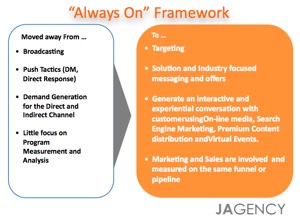Former Avaya CMO Argues For, Always-On Approach To Demand Engines
- Published in Feature Articles
One of the earliest adopters of lead nurturing and campaign management is now proposing that drip marketing and long-term campaigns aren’t keeping up with the “always on” aspect of the Web 2.0 world. During a recent presentation at the IDC Sales & Marketing Effectiveness Summit in New York, ex-Avaya CMO Jocelyn Attal argued that time is now for a fundamental approach to engaging BtoB buyers.
Attal has started a new company called JAgency whose mission is to guide companies toward an “Always On Lead Engine.” That engine will be driven by a continuous interactive “live experience” that allows prospects to connect at all times through personalized interfaces. The always-on lead engine, according to Attal, will be a demand creation strategy that brings all elements of technology together with a human touch for prospects.
“The customer wants to get information out of any interaction with a company,” she says. “The information dictates the customer experience. The way I see it an ‘always on’ lead engine will combine social media, with interactive websites, contact centers and live chat with the end goal of human interaction and eventually customer conversion. Yes, it will lean heavily on a website. But that website must be personalized for the customer and affordable for the company to deliver.”
Attal’s approach is based on economic conditions and the competitive landscape. The economy has pressurized sales performance, go-to-market cycles, and the ability to bear the costs of individual lead campaigns. The campaign approach, she says, is too expensive to sustain. “Always on” takes the concept of a campaign and stretches it across a real-time interactive experience. From a competitive standpoint, she believes the campaign method of lead management takes too long to collect, analyze and then execute against. Using interactive touchpoint is more visible and immediate.
The first step in building this engine is the multi-touch point customer interactions. The second stage is in constantly changing the offer. Maybe it revolves from loyalty, to new pricing, new applications for the customer, or simply new messaging. The offer, she believes, must be relevant to that company and its place in the current market.
As an example of the new approach she points to an IT company which has 1,000 key prospects. For that set of companies the IT company would design web sites that contained personalized content, and would automatically route emails to the proper contact, and eventually to a live agent or executive. Product information would also be customized and always available, once again with live agents available for questions. All activity at this website would be monitored and followed up where necessary.
The approach begs the question, what’s the difference between the Live Experience and a virtual trade show? Attal is comfortable with the comparison and virtual events will be a key component for JAgency. The difference is the combined usage of email, social networks and the customization of the web pages.
“I see this growing rapidly for IT, pharma and retail,” she says. “Keep the conversation going and keep the action going. That is best done through the live experience.”

